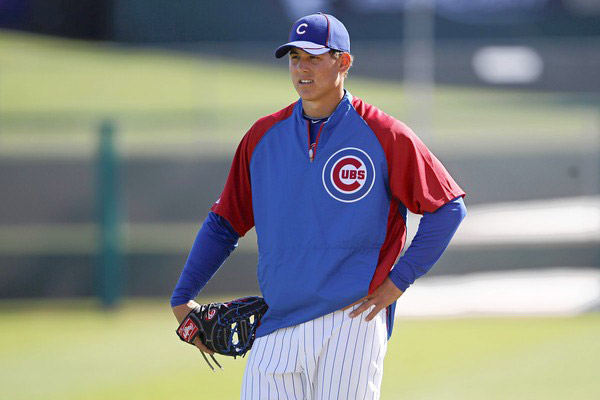
A friend, who is not a Cubs fan, asks about Anthony Rizzo: "do Cubs fans know he played 50 games for the Padres last year and wasn't that good?"
I don't know. Either way, there's not a lot for Cubs fans to do this year except pull for Rizzo, who was supposed to inherit Adrian Gonzalez's big shoes in San Diego before he was traded for Andrew Cashner (now in the Texas League). And there's reason to think he'll be better for the Cubs than he was in his brief callup.
In 2011, Rizzo—who's followed Jed Hoyer from the Red Sox to the Padres to the Cubs in his six professional seasons—was raking for the Padres' Triple A affiliate, like the Iowa Cubs a Pacific Coast League team. In 356 at bats, Rizzo hit .331/.404/.652, with 26 home runs and 34 doubles, walking 10 percent and striking out 21.5 percent of the time.
Then he played 49 games at the big-league level; in 128 at-bats, he hit .141/.281/.242 with one home run and eight doubles in one of the most hitter-unfriendly parks in baseball: "Petco Park is ridiculous. The Padres usually lose anywhere from 10 to 30 points off their team on-base percentage and 30 to 70 points off their team slugging percentage when they play at home."
Anywhere else… actually, Rizzo hit better in Petco, though the sample size is admittedly small. Rizzo's big problem was that he struck out 30 percent of the time, which is not quite Adam Dunn-level whiffing but would put him in the top five this year, just below Bryan LaHair. But, also like LaHair, he showed a respectable eye, walking 13.7 percent of the time, his best mark at any professional level.
Anyway, Rizzo returned to the PCL after the Cashner trade, and again hit well; as of his callup, he was leading the PCL in home runs, total bases, and OPS. He actually hit better than his 2011 PCL stint: in 257 at-bats, about 72 percent as many as last year, he hit three fewer home runs. His strikeout rate is down (21.5 to 18.3); his batting average is up (.331 to .342); his slugging percentage is up (.652 to .696), and his on-base percentage is basically the same (.404 to .405), despite a drop in his batting average on balls in play (.369 to .357, also not far from LaHair's .376), a reasonable proxy for luck. His walk rate is down substantially, 13.7 to 8.1 percent, but why bother walking when you're hitting .342?
It's basically all encouraging. Despite the fact that his BABIP has regressed, he's hitting the ball harder and striking out less than he did last year. One of the questions following Rizzo was whether he'd grow as a power hitter, a critical tool for major-league first basemen, and he's more than done so from 2011 to 2012. Rizzo is putting up numbers strikingly similar to LaHair's 2011 season at Iowa… only he's seven years younger.
After a great minor-league campaign last year, Rizzo fell apart in the majors. But he's not only moved to a much friendlier park, he also managed to improve on his PCL numbers, which bodes well.
Related: The Cashner-Rizzo deal isn't as bad as it looks at first glance for the Padres, but it still looks pretty good for the Cubs.
Photograph: Chicago Tribune


